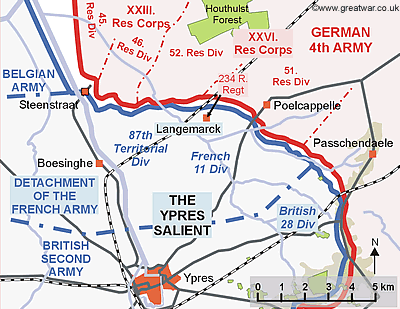 German deserter reveals plan to attack with gas
German deserter reveals plan to attack with gas
13 April 1915
On Tuesday 13th April an incident occurred which gave a warning to the Allies of an imminent German attack on their line with a new deadly weapon at Ypres. Had the Allies taken this fortuitous warning more seriously, the course of events of the next few weeks might have been very different.
Private August Jaeger Deserts his Post

On 13th April a German soldier climbed out of his front-line trench and scrambled across the few hundred metres of no-man's-land, making for the French front line. The soldier's name was Private August Jaeger. He had been called up on 4th August 1914. On 9th November he was attached as an Automobile Driver to the 234. Reserve-Infanterie-Regiment (51. Reserve-Division). For whatever reason, he decided to desert his post on 13th April.(1)
Desertion was not uncommon in this sector; the German and French soldiers had frequently fraternized with one another in this quiet sector during the winter months of 1914/1915. It was a serious concern to senior German commanders that a deserter might indeed give away the secret of the new gas weapon before wind conditions were favourable enough to carry out the first trial attack.(2)
Jaeger got to the French line successfully without being seen and clambered over the parapet into the French front line trench near Langemarck. At that time this sector of the line was held by the 4th Battalion of Chasseurs of the French 11th Division. The divisional commander was General Edmond Ferry.
Jaeger is Interrogated
During his subsequent interrogation at the French 11th Division headquarters August Jaeger readily gave details about German troop strength in the trenches, daily routines and German gun batteries in the vicinity:
“During the day 1st line trenches are occupied by one Section per Company. At night the strength is doubled and from 4 to 6 in the morning, the whole Company is in position. Each Company has three machine guns in the 1st line, flanking each other, while the fourth gun is in reserve in rear.
Companies spend 8 days on the front and 8 days at rest. One battalion is always at rest in huts constructed in the small wood CALVAIRE ... to the East of WEST ROOSEBEKE. Two other battalions rest at OOSTNIEUWKERKE.
The 380 mm. gun has just been mounted on a cemented platform in the S.W. of d'HOUTHULST forest. This gun has not yet fired. A battery of 210 mm. mortars, another of 155 mm. guns and several others of 77 mm. are approximately 1 kilometre WEST of POELCAPPELLE railway station.” (3)
He also told the French exactly which house was being used by his commanding officer as a forward headquarters on the road leading north from Poelcappelle:
“The report centre of the Colonel Commanding the 234th Regiment is at the Northern exit from POELCAPPELLE, and is the last house in red brick on the left of the exit.” (4)
Jaeger Reveals a New Secret Weapon: Asphyxiating Gas
The most important information that Jaeger brought with him from the German side was about an impending attack planned against the French front line. He revealed that 80 bottles of asphyxiating gas had been installed in the German front-line trenches. He was referring to the 80 cylinders in four F-Batteries located in the trench held by his company. On a given signal Jaeger claimed that the bottles of gas would be uncorked and the gas would be released. The plan was for the gas to be carried by the wind towards the French trenches.
The intention was to asphyxiate the French soldiers in their trenches, enabling the advancing German infantry to take the enemy's trenches without sustaining casualties of their own. Jaeger informed his interrogators that in order to prevent German troops from being intoxicated by the gas, each soldier had been provided with a packet of gauze steeped in oxygen to cover his mouth and nose.
Jaeger's statement was given as follows by the French Officer interpreter of the French 11th Division:
“An attack is planned for the near future against the French trenches of the above mentioned sector. With this object in view four batteries have been placed in position in the first line trenches [i.e. in the section held by Jaeger's company]; these batteries each have 20 bottles of asphyxiating gas. Each Company has 4 such batteries. Each battery has 5 gunners. At a given signal - 3 red rockets fired by the artillery - the bottles are uncorked, and the gas on escaping, is carried by a favourable wind towards the French trenches. This gas is intended to asphyxiate the men who occupy the trenches and to allow the Germans to occupy them without losses. In order to prevent the men being themselves intoxicated by the gas, each man is provided with a packet of tow steeped in oxygen.
Since yesterday (13th inst.), all trains and convoys in position at ROULERS and RUMBEKE have been warned to be ready.
Companies are about 160 strong on an average and are mostly commanded by active Army Lieutenants.” (5)
Next>> The French react to the German deserter's information
Acknowledgements
(1) Gas! The Battle for Ypres, 1915, p. 11-12
(2) Gas! The Battle for Ypres, 1915, p. 25
(3) Official History of the Canadian Forces in The Great War 1914-1919, Volume I, Chronology, Appendices and Maps, Appendix no. 320, p. 228-229
(4) Official History of the Canadian Forces in The Great War 1914-1919, Volume I, Chronology, Appendices and Maps, Appendix no. 320, p. 228-229
(5) Official History of the Canadian Forces in The Great War 1914-1919, Volume I, Chronology, Appendices and Maps, Appendix no. 320, p. 228-229